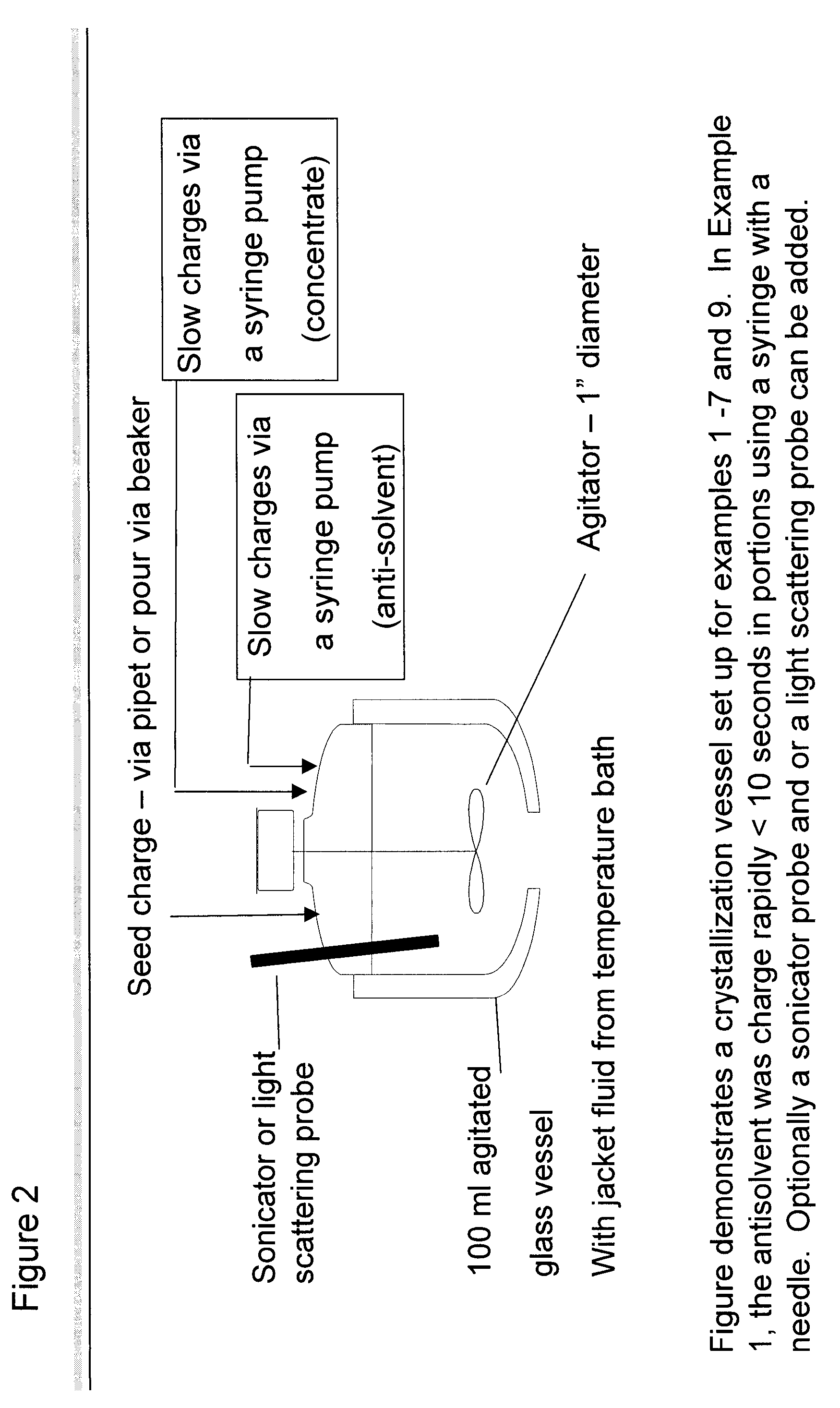Processes and Apparatuses for the Production of Crystalline Organic Microparticle Compositions by Micro-Milling and Crystallization on Micro-Seed and Their Use
a technology of crystallization and microparticles, which is applied in the direction of phosphorous compound active ingredients, immunological disorders, metabolism disorders, etc., can solve the problems of limited operator exposure to active compounds, high cost, and high operational cost of dry milling, and achieves low dust production. , the effect of reducing the number of active compounds
- Summary
- Abstract
- Description
- Claims
- Application Information
AI Technical Summary
Benefits of technology
Problems solved by technology
Method used
Image
Examples
example 1
Compound A=Cox II Inhibitor
[0102]This series of semi-batch crystallizations demonstrate the ability to create a high surface area micro-seed by media milling and the effects of varying the amounts of micro-seed introduced during crystallization to produce final products of variable surface area and particle size. The surface area of the final product is comparable to jet milled material. Also illustrated are experiments which show that the addition of supplemental additives to the micro-seed after milling and prior to the crystallization process can increase the surface area of the resultant product, lire anti-solvent was added to cause crystallization.
[0103]Jet Milling of Compound A
[0104]Compound A was Jet milled using a typical condition ranging between 1-1.9 mm nozzles, 43-45 psig jet pressure, and 7000-21000 rpm for an 100AFG jet mill of Hosakawa Micron, Inc. The resultant surface area of the material was 2.5 m2 / g.
[0105]Milling of Micro-Seed for Examples 1A-1E
[0106]On Day 0, the...
example 2
Compound A=Cox II Inhibitor
[0116]This series of examples demonstrate that physical slurry handling characteristics can be enhanced when supplemental additives such as anon-ionic or an ionic surfactant are added to the micro-seed wet-milling process. The supplemental additive was added to the micro-seed slurry after milling for use in the crystallization process resulting in a similar increase in product surface area as shown in Example 1D and 1E above. In addition, samples of the slurry were taken at 15 and 60 minutes to demonstrate that the milling tune can be changed as needed to afford material after crystallization of different surface area. Again, the surface area is comparable to that of jet milled material, but is produced directly by the process of the present invention.
[0117]Milling of Micro-Seed for Example 2A and 2B
[0118]On Day 0, the disc mill containing 1 mm yttrium stabilized zirconium oxide beads was flushed with 50% n-heptane and 50% toluene and the contents of the m...
example 3
Compound B=Cox II Inhibitor
[0127]This series of examples demonstrate the ability to replace pin milling for a compound known to exhibit “meltback”. The form of the crystal is controlled throughout the process even though four other possible crystalline forms of Compound B are known. The crystallizations were performed at elevated temperature. This example demonstrates that the surface area can be controlled by the addition of different levels of micro-seed.
[0128]Pin Milling of Compound B
[0129]Compound B was Pin milled for pharmaceutical use using typical conditions for an Alpine® UPZ160 mill (Hosakawa) and with a high process nitrogen flow. This compound is difficult to mill due to the low melting point of the compound. Cold nitrogen at 0° C. and 40 SCFM (standard cubic feet per minute) was applied as a pin rinse of the mill during processing to keep the processing temperature below the melting point of the compound. Milling was not possible without this extra step. The resultant su...
PUM
| Property | Measurement | Unit |
|---|---|---|
| mean particle size | aaaaa | aaaaa |
| mean particle size | aaaaa | aaaaa |
| mean particle size | aaaaa | aaaaa |
Abstract
Description
Claims
Application Information
 Login to View More
Login to View More - R&D
- Intellectual Property
- Life Sciences
- Materials
- Tech Scout
- Unparalleled Data Quality
- Higher Quality Content
- 60% Fewer Hallucinations
Browse by: Latest US Patents, China's latest patents, Technical Efficacy Thesaurus, Application Domain, Technology Topic, Popular Technical Reports.
© 2025 PatSnap. All rights reserved.Legal|Privacy policy|Modern Slavery Act Transparency Statement|Sitemap|About US| Contact US: help@patsnap.com



